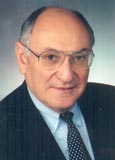A-F | G-H | I-L | M-Q | R-S | T-Z
 Yasuo Ihara
Yasuo Ihara
Neurofibrillary Tangles/Paired Helical Filaments (1981-83)
Abstract: Neurofibrillary tangles, one of the hallmarks of Alzheimer’s disease, had been a target of modern neuropathology based on electron microscopy. In 1960s their unit fibrils were found to be paired helical filaments (PHF), the unique appearance of which attracted many researchers to their nature. In the late 1970s, a keen interest in their constituents at the molecular levels had increasingly grown, but electron microscopic approach failed to address the issue. I describe here what was going on at the turning point when electron microscopic study yielded immunocytochemical approach and direct characterization by isolation, with some emphasis on the situation in Japan. Personal memories are provided about Dr Selkoe’s lab (1981-82) in Mailman Research Center, Belmont, Boston, where we encountered a series of remarkable properties of PHF. How insolubility of PHF, and smearing on the blot was found is described.
 Khalid Iqbal, Inge Grundke-Iqbal
Khalid Iqbal, Inge Grundke-Iqbal
Discoveries of Tau, Abnormally Hyperphosphorylated Tau And Others of Neurofibrillary Degeneration: A Personal Historical Perspective
Alzheimer disease was described by Alois Alzheimer in 1907, but it was not until ~60-70 years later that any new significant developments were reported on the pathology of this disease. The discoveries that laid down the foundation for the exciting research that has been carried out during the last ~20 years and that have significantly enhanced our understanding of the disease are the ultrastructure of neurofibrillary tangles and neuritic (senile) plaques, the clinical-pathological correlation of these lesions to the presence of dementia, and the bulk isolation and protein composition of paired helical filaments and plaque amyloid. We discovered tau as the major protein subunit of paired helical filaments/neurofibrillary tangles, the abnormal hyperphosphorylation of this protein in this lesion and in Alzheimer brain cytosol and the gain of toxic function by the cytosolic abnormally hyperphosphorylated tau in Alzheimer brain. Here we present a personal historical account of the work in our laboratories that led, in 1986, to the discoveries of tau and its abnormal hyperphosphorylation in paired helical filaments and Alzheimer brain cytosol. This article also describes several major findings which subsequently resulted from the abnormal hyperphosphorylation of tau and in a large part account for the current understanding of the role of this lesion in Alzheimer disease and other tauopathies.
 Kurt A. Jellinger
Kurt A. Jellinger
Clinicopathological analysis of dementia disorders in the elderly - An update
Abstract: A retrospective clinico-pathological study of a consecutive autopsy series of 1050 elderly demented individuals (mean age 82.4+/-6.0 years; MMSE < 20) was performed. Clinical diagnoses were probable or possible Alzheimer disease (62.9%), nonspecific degenerative dementia (10.4%), vascular dementia (10%), Parkinson disease with dementia (9.5%), 1.5% mixed dementia, and 5.7% other disorders. At autopsy, 86% revealed Alzheimer-related pathology, but only 42.8% showed “pure” Alzheimer disease, with additional cerebrovascular lesions in 22.6% and Lewy body pathology in 10.8%, while among 660 cases of clinically suspected Alzheimer disease, Alzheimer pathology was seen in 93%, only 44.7% in “pure” form, and additional vascular lesions and Lewy bodies in 27.7 and 10%, respectively. The non-Alzheimer cases included Huntington and Creutzfeldt-Jakob disease, frontotemporal dementias, and others. These and other recent data indicate that in patients with the clinical diagnosis of Alzheimer disease its combination with cerebrovascular lesions and Lewy body pathologies is rather frequent. Comparison of clinical and postmortem diagnoses revealed postmortem confirmation of Alzheimer disease in 93%, of mixed and vascular dementia in 60 and 52.3%, respectively. 78% of clinically suspected degenerative dementias were pathologically definite Alzheimer disease, while in the clinical Parkinson + dementia group dementia with Lewy bodies accounted for 35%, Parkinson+Alzheimer disease, and “pure” Alzheimer disease for 29%, each. A sample of 207 prospectively studied elderly showed significant negative correlation between the preterminal psychostatus assessed by MMSE and the neuritic Braak stages, with a broad “gray” zone Alzheimer lesions in mildly to moderately demented subjects. Similar relations between CDR and Braak stages were seen in very old subjects. The present study and the results of other recent series indicate increasing agreement between clinical and autopsy diagnoses in demented aged individuals with variable accuracy rates for different forms of dementia disorders.
 Gail V.W. Johnson
Gail V.W. Johnson
Tau phosphorylation and proteolysis: insights and perspectives
Abstract: In 1992 little was known about the specific protein kinases that phosphorylate tau and the proteases that regulate tau turnover. Although we had already demonstrated that tau was a substrate of the calcium-activated protease calpain, our publication entitled, "Phosphorylation by cAMP-dependent protein kinase inhibits the degradation of tau by calpain" was the first demonstration that phosphorylation by a specific kinase could inhibit the proteolysis of tau by calpain. At the time these findings suggested that the abnormal phosphorylation of tau in Alzheimer's disease brain could result in impaired tau turnover and thus result in an abnormal accumulation of the protein that could contribute to the formation of pathological lesions. Since this initial finding, much has been learned about the proteolysis of tau, not only by calpain, but by other proteases as well. However, much remains unknown about how phosphorylation regulates tau turnover in vivo and the specific proteases involved. In this article we give a brief history of our initial findings and then discuss subsequent studies from our laboratory, as well as others, on tau proteolysis and modulation by phosphorylation and how these findings contribute to our understanding of the posttranslational processing of tau in Alzheimer's disease.
 Zaven Khachaturian
Zaven Khachaturian
Diagnosis of Alzheimer's Disease: Two-Decades of Progress
A retrospective view of the critical events and advances in the development of criteria, instruments and algorithms in the diagnosis of Alzheimer’s disease. The review is from the vantage point of the National Institute on Aging and its role in the development of the national infrastructure, in the US, for clinical research on dementia. The paper discusses future research needs and challenges for developing new diagnostic armamentarium for early and accurate detection of neurodegenerative processes of dementia in the early prodromal stages or during early mild cognitive impairments.
 Michael Kidd
Michael Kidd
The history of the paired helical filaments
Abstract: The original recognition of the paired helical filaments is discussed and amplified. The original description of what are now the neuropil threads is mentioned. The ensuing importance of both these structures is emphasised and a morphology-based hypothesis of the development of the disease from the original stimuli is offered.
 Kenneth S. Kosik
Kenneth S. Kosik
Traveling the Tau Pathway: A Personal Account
Studies of the tau protein and its pathological fate as a neurofibrillary tangle have been a pillar of Alzheimer’s disease research. The understanding of the fundamental position that tau occupies in the disease cascade is a tribute to an international group of scientists who brought rigor, candid assessments of data, and critical thinking to the problem. The tau pathway winds its way from astute clinical observations to pathological correlations, from molecular and cellular experiments to mining informatic data, and from animal behavior to the biophysics of protein structure. For most the vindication of this tireless effort will come from tau-based therapies; but for others the remarkable biology revealed by the Alzheimer disease process has been its own reward.
 José Manuel Martínez Lage
José Manuel Martínez Lage
100 Years of Alzheimer’s Disease (1906-2006)
Abstract: As we commemorate the first centennial since Alzheimer’s disease (AD) was first diagnosed, this article casts back into the past while also looking to the future. It reflects on the life of Alois Alzheimer (1864-1915) and the scientific work he undertook in describing the disorder suffered by Auguste D. from age 51 to 56 and the neuropathological findings revealed by her brain, reminding us of the origin of the eponym. It highlights how, throughout the 1960’s, the true importance of AD as the major cause of late life dementia ultimately came to light and narrates the evolution of the concepts related to AD throughout the years and its recognition as a major public health problem. Finally, the article pays homage to the work done by the Alzheimer’s Association and the research undertaken at the Alzheimer’s Disease Centres within the framework of the National Institute on Aging (NIA) Program, briefly discussing the long road travelled in the fight against AD in the past 25 years and the scientific odyssey that we trust will result in finding a cure.


